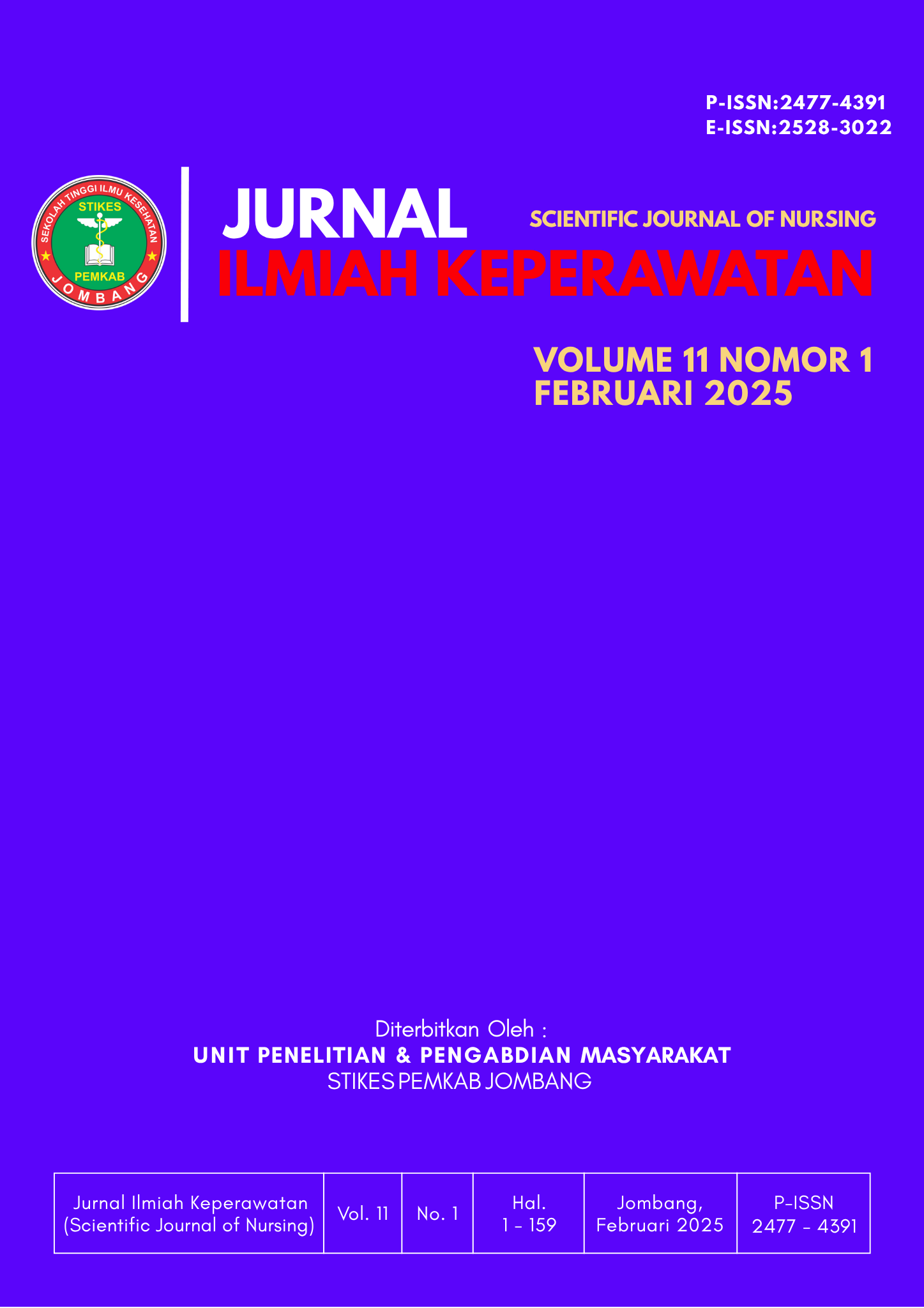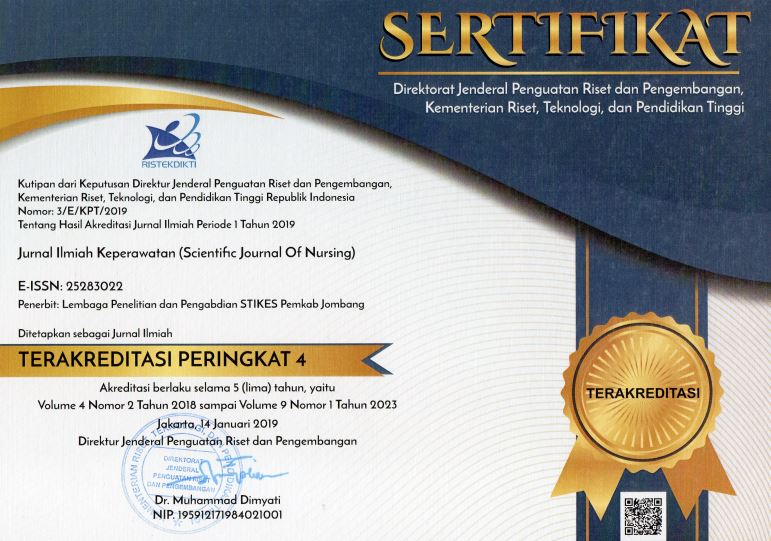Studi kasus: Asuhan keperawatan pasien dengan cedera kepala berat di Instalasi Gawat Darurat (IGD)
Case Study: Nursing care for patient with severe head injury in the Emergency Department
DOI:
https://doi.org/10.33023/jikep.v11i1.2365Keywords:
Asuhan keperawatan, bersihan jalan nafas tidak efektif, cidera kepala beratAbstract
Cedera kepala berat merupakan salah satu tantangan kesehatan yang paling mengkhawatirkan di seluruh dunia. Kondisi ini menjadi penyebab utama mortalitas, morbiditas, dan masalah kesehatan serius lainnya. Cedera kepala dapat disebabkan oleh berbagai faktor, seperti terjatuh dari ketinggian, kecelakaan di rumah, di kantor, atau saat berolahraga, serta penyerangan fisik, tembakan ke kepala, dan kecelakaan lalu lintas. Oleh karena itu, penelitian ini bertujuan untuk memberikan asuhan keperawatan bagi pasien yang mengalami cedera kepala berat akibat kecelakaan lalu lintas. Metode penelitian yang digunakan deskriptif dengan pendekatan studi kasus. Sampel berjumlah satu orang yang mengalami kegawatdaruratan di IGD RS Abdoel Moeloek Lampung. Pengumpulan data dilakukan melalui anamnesis, pengkajian Primer: Airway, Breathing, Circulation, Disability dan studi dokumentasi rekam medik. Hasil penelitian menunjukkan bahwa pasien berada dalam kategori triage warna merah, dengan diagnosa utama adalah bersihan jalan napas tidak efektif. Dalam penanganannya dilakukan penerapan manajemen jalan napas yang meliputi posisi semi-fowler, pemasangan OPA, tindakan suction, dan pemberian oksigenasi melalui NRM dengan aliran 15 liter per menit. Penelitian ini menekankan betapa pentingnya prosedur penanganan jalan napas yang cepat dan akurat dalam mengelola pasien cedera kepala berat, guna mencegah komplikasi yang lebih serius dan meningkatkan peluang pemulihan.
Downloads
References
Alarcon, J. D., Rubiano, A. M., Okonkwo, D. O., Alarcón, J., Martinez-Zapata, M. J., Urrútia, G., & Bonfill Cosp, X. (2017). Elevation of the head during intensive care management in people with severe traumatic brain injury. Cochrane Database of Systematic Reviews, 2017(12). https://doi.org/10.1002/14651858.CD009986.pub2
Amal, S. T., Eman, S. O., & Eman, A. M. E. (2022). Effectiveness of Semi-fowler’s Position on Hemodynamic Function among Patients with Traumatic Head Injury. Journal of Nursing Science, 15, 352–362. https://doi.org/10.1089/acm.2017.0023
American Health Care Academy. (2024). Oropharyngeal Airway: How To Insert an Oropharyngeal Airway. America health care Academy. https://cpraedcourse.com/blog/oropharyngeal-airway/
Amy, W., Kevin, F., Justin, W., & Christina, Kwasnica, Gary, G. (2021). Traumatic Brain Injury. Braddom’s Physical Medicine and Rehabilitation, 916–953. https://doi.org/https://doi.org/10.1016/B978-0-323-62539-5.00043-6
Ardhiansyah, A. O. (2022). Prinsip Dasar Penanganan Trauma. Airlangga University Press.
Ariyani, H., & Robby, A. (2023). Buku Ajar Keperawatan Gawat Darurat. Edu Publisher.
Bartlett, & Jones. (2022). Emergency Care and Transportation of the Sick and Injured. American Academy of Orthopaedic Surgeons.
Bossers, S. M., Verheul, R., van Zwet, E. W., Bloemers, F. W., Giannakopoulos, G. F., Loer, S. A., Schwarte, L. A., & Schober, P. (2023). Prehospital Intubation of Patients with Severe Traumatic Brain Injury: A Dutch Nationwide Trauma Registry Analysis. Prehospital Emergency Care, 27(5), 662–668. https://doi.org/10.1080/10903127.2022.2119494
Franjic, S. (2020). Head Injuries, a general approach. Iberoamerican Journal of Medicine, 2(1), 19–23. https://doi.org/10.53986/ibjm.2020.0005
Goldman, L., Siddiqui, E. M., Khan, A., Jahan, S., Rehman, M. U., Mehan, S., Sharma, R., Budkin, S., Kumar, S. N., Sahu, A., Kumar, M., & Vaibhav, K. (2022). Understanding Acquired Brain Injury: A Review. Biomedicines, 10(9). https://doi.org/10.3390/biomedicines10092167
Henrik, B., Patrick, E., Karl, B., Michael, J., Peter, T., & John, C. (2022). Cervical immobilization in trauma patients: soft collars better than rigid collars? A systematic review and meta-analysis. Springer-Verlag GmbH Germany, 12, 3378–3391. https://doi.org/10.1007/s00586-022-07405-6
Kurniawan, W. D., Riduansyah, M., & Mahmudah, R. (2023). Efektivitas Terapi O2 terhadap Hemodinamik Pasien Cedera Kepala Sedang dan Berat di Instalasi Gawat Darurat. Jurnal Keperawatan, 15(2), 569–576. https://doi.org/10.32583/keperawatan.v15i2.944
Mat, B., Sanz, L. R. D., Arzi, A., Boly, M., Laureys, S., & Gosseries, O. (2022). New Behavioral Signs of Consciousness in Patients with Severe Brain Injuries. Seminars in Neurology, 42(3), 259–272. https://doi.org/10.1055/a-1883-0861
Mena, J. H., Sanchez, A. I., Rubiano, A. M., Peitzman, A. B., Sperry, J. L., Gutierrez, M. I., & Puyana, J. C. (2021). Effect of the modified glasgow coma scale score criteria for mild traumatic brain injury on mortality prediction: Comparing classic and modified glasgow coma scale score model scores of 13. Journal of Trauma - Injury, Infection and Critical Care, 71(5), 1185–1193. https://doi.org/10.1097/TA.0b013e31823321f8
Nasser, M., Fabienne, B., Mohammad, R., Hassan, A., & Sarah, M. (2016). Traumatic Brain Injury and Blood-Brain Barrier Cross-Talk. CNS Neurol Disord Drug Targets. Bentham Science Publishers, 15. https://doi.org/http://doi.org/10.2174/1871527315666160815093525
Susilawati, F., Presti, L., & Purwanza, W. (2024). Buku Ajar Keperawatan Medikal Bedah III. Mahakarya Citra Utama Group.
Venturini, S., Still, M., Vycheth, Nang, S., Vuthy, D., & Park, K. (2019). The National Motorcycle Helmet Law at 2 Years: Review of Its Impact on the Epidemiology of Traumatic Brain Injury in a Major Government Hospital in Cambodia. world Neurosurgery, 125, 320–326. https://doi.org/http://doi.org/0.1016/j.wneu.2019.01.255
Wardani, A. K. (2017). Analisis Asuhan Keperawatan Pada Pasien Cedera Kepala Berat Dengan Masalah Keperawatan Ketidakefektifan Bersihan Jalan Nafas Di Instalasi Gawat Darurat Rsud Prof. Dr. Margono Soekarjo Purwokerto [Sekolah Tinggi Ilmu Kesehatan Muhammadiyah Gombong]. http://repository.unimugo.ac.id/id/eprint/731
Published
How to Cite
Issue
Section
Authors who publish with Jurnal Ilmiah Keperawatan (Scientific Journal of Nursing) agree to the following terms:
- Authors retain copyright and grant Jurnal Ilmiah Keperawatan (Scientific Journal of Nursing) the right of first publication with the work simultaneously licensed under a Creative Commons Attribution 4.0 International License that allows others to remix, adapt and build upon the work with an acknowledgment of the work's authorship and of the initial publication in Jurnal Ilmiah Keperawatan (Scientific Journal of Nursing).
- Authors are permitted to copy and redistribute the journal's published version of the work (e.g., post it to an institutional repository or publish it in a book), with an acknowledgment of its initial publication in Jurnal Ilmiah Keperawatan (Scientific Journal of Nursing).









